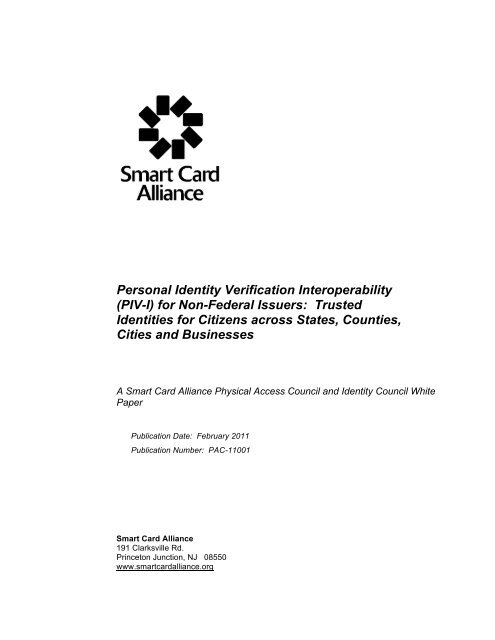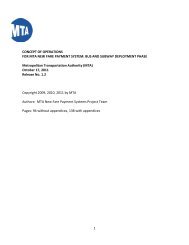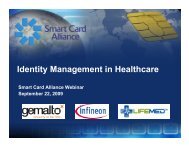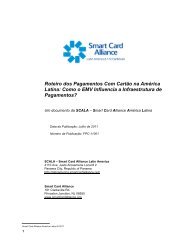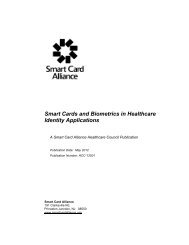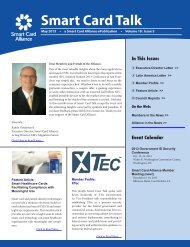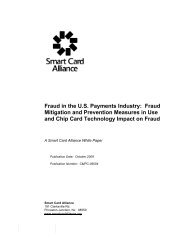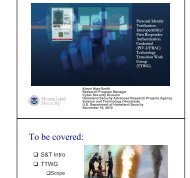PIV-I White Paper - FINAL - 022111 - Smart Card Alliance
PIV-I White Paper - FINAL - 022111 - Smart Card Alliance
PIV-I White Paper - FINAL - 022111 - Smart Card Alliance
You also want an ePaper? Increase the reach of your titles
YUMPU automatically turns print PDFs into web optimized ePapers that Google loves.
Personal Identity Verification Interoperability(<strong>PIV</strong>-I) for Non-Federal Issuers: TrustedIdentities for Citizens across States, Counties,Cities and BusinessesA <strong>Smart</strong> <strong>Card</strong> <strong>Alliance</strong> Physical Access Council and Identity Council <strong>White</strong><strong>Paper</strong>Publication Date: February 2011Publication Number: PAC-11001<strong>Smart</strong> <strong>Card</strong> <strong>Alliance</strong>191 Clarksville Rd.Princeton Junction, NJ 08550www.smartcardalliance.org
About the <strong>Smart</strong> <strong>Card</strong> <strong>Alliance</strong>The <strong>Smart</strong> <strong>Card</strong> <strong>Alliance</strong> is a not-for-profit, multi-industry association working to stimulate theunderstanding, adoption, use and widespread application of smart card technology. Throughspecific projects such as education programs, market research, advocacy, industry relations andopen forums, the <strong>Alliance</strong> keeps its members connected to industry leaders and innovativethought. The <strong>Alliance</strong> is the single industry voice for smart cards, leading industry discussion onthe impact and value of smart cards in the U.S. and Latin America. For more information pleasevisit http://www.smartcardalliance.org.Copyright © 2011 <strong>Smart</strong> <strong>Card</strong> <strong>Alliance</strong>, Inc. All rights reserved. Reproduction or distribution of thispublication in any form is forbidden without prior permission from the <strong>Smart</strong> <strong>Card</strong> <strong>Alliance</strong>. The <strong>Smart</strong> <strong>Card</strong><strong>Alliance</strong> has used best efforts to ensure, but cannot guarantee, that the information described in this reportis accurate as of the publication date. The <strong>Smart</strong> <strong>Card</strong> <strong>Alliance</strong> disclaims all warranties as to the accuracy,completeness or adequacy of information in this report.
TABLE OF CONTENTS 1 INTRODUCTION ............................................................................................................................................ 4 1.1 IDENTITY CREDENTIALS: THE MOVE TOWARD <strong>PIV</strong>-‐I.................................................................................................. 4 2 FOUNDATIONS FOR CREDENTIAL INTEROPERABILITY.................................................................................... 6 2.1 POLICY ............................................................................................................................................................ 6 2.1.1 Uniform Electronic Transaction Act ...................................................................................................... 6 2.1.2 Deficit Reduction Act............................................................................................................................. 6 2.1.3 REAL ID Act and Western Hemisphere Travel Initiative ........................................................................ 6 2.1.4 U.S. Drug Enforcement Administration’s Rules for Electronically Prescribing Controlled Substances .. 7 2.1.5 Draft National Strategy for Trusted Identities in Cyberspace ............................................................... 7 2.2 PROCESS.......................................................................................................................................................... 7 2.3 TECHNOLOGY.................................................................................................................................................... 8 2.3.1 PKI and Trust......................................................................................................................................... 8 2.3.2 <strong>Smart</strong> <strong>Card</strong> Technology......................................................................................................................... 9 2.3.3 Biometrics and <strong>Smart</strong> <strong>Card</strong> Technology.............................................................................................. 10 2.3.4 <strong>PIV</strong>-‐I and <strong>PIV</strong>-‐C .................................................................................................................................... 10 3 BUSINESS JUSTIFICATION ........................................................................................................................... 12 3.1 ADVANTAGES OF ADOPTING FIPS 201 ................................................................................................................ 12 3.2 EXAMPLES...................................................................................................................................................... 12 3.2.1 National Cancer Institute.................................................................................................................... 12 3.2.2 Transglobal Secure Collaboration Program ........................................................................................ 13 3.2.3 Department of Agriculture.................................................................................................................. 13 3.2.4 State of Illinois .................................................................................................................................... 13 3.2.5 GSA ..................................................................................................................................................... 13 3.2.6 Other Ongoing Efforts......................................................................................................................... 14 3.3 SUMMARY...................................................................................................................................................... 14 4 STATE PROGRAMS...................................................................................................................................... 15 5 CONSIDERATIONS FOR FUTURE DIRECTIONS .............................................................................................. 18 5.1 OTHER FORM FACTORS USING SMART CARD TECHNOLOGY ..................................................................................... 18 5.2 SMART CARD TECHNOLOGY AND APPLICATIONS..................................................................................................... 19 6 CONCLUSIONS ............................................................................................................................................ 20 6.1 POLICY .......................................................................................................................................................... 20 6.2 PROCESS........................................................................................................................................................ 20 6.3 TECHNOLOGY.................................................................................................................................................. 20 6.4 SUMMARY...................................................................................................................................................... 20 7 REFERENCES ............................................................................................................................................... 21 8 PUBLICATION ACKNOWLEDGEMENTS......................................................................................................... 22 9 APPENDIX A: STANDARDS EFFORTS ........................................................................................................... 24 <strong>Smart</strong> <strong>Card</strong> <strong>Alliance</strong> © 20113
1 IntroductionSolid identity management and strong credentialing practices are critical to governmentorganizations and enterprises that must verify the identities of a wide variety of individuals—employees, business partners, emergency response officials, and citizens. As a resultgovernments around the world are putting in place the legal framework to leverage strong identitycredentials for eGovernment, eHealth and eCommerce and use of these credentials is growing.This brief talks about the progress in the United States in establishing a standard for identity andcredentialing and the associated and necessary trust framework.Driven by the issuance of Homeland Security Presidential Directive 12 (HSPD-12) in 2004, theU.S. Federal Government has invested significant effort and resources in implementing robust,interoperable credentialing processes and technologies. The resulting standard, FederalInformation Processing Standard (FIPS) 201, Personal Identity Verification (<strong>PIV</strong>) of FederalEmployees and Contractors, provides a framework of the policies, processes, and technologyrequired to establish a strong, comprehensive program. And in fact, since 2005, the FederalGovernment has successfully used this framework to issue over 5 million <strong>PIV</strong> cards to Federalemployees and contractors. In addition, Federal agencies have developed an infrastructure forusing these interoperable credentials to support additional requisite functions, including thefollowing:• Physical security, including facility access and video analytics• Logical security, including network and application access• Incident monitoring and response• Encryption and protection of sensitive dataState and local governments and other organizations can leverage the Federal program. Twopublications—Personal Identity Verification Interoperability (<strong>PIV</strong>-I) for Non-Federal Issuers 1 (issued by theFederal CIO Council in May 2009) and <strong>PIV</strong>-I Frequently Asked Questions 2 — provide states, localjurisdictions, and commercial organizations with applicable standards and guidance. The definition of <strong>PIV</strong>interoperability builds on the Federal <strong>PIV</strong> standard and the supporting framework of policies, processes,and technologies. The maturity of the Federal standards, the availability of compliant commercial off-theshelf(COTS) products, and the ability to use a single, interoperable, and secure <strong>PIV</strong> credential acrossmultiple application areas can enable states, local jurisdictions, and enterprises to improve their securitypostures, infrastructures, and services for employees, contractors, businesses, and consumers. Usingthe <strong>PIV</strong>-I standards helps to provide a foundation for a cost-effective approach.1.1 Identity Credentials: The Move toward <strong>PIV</strong>-IMany state and local organizations point to the <strong>PIV</strong> standard as a way to achieve a more holisticapproach to issuing identity credentials, and improving their own business processes, notwithstanding theadditional requirements of implementing supporting infrastructure and applications. More than 16 statesare currently planning or implementing some form of <strong>PIV</strong>-interoperable (<strong>PIV</strong>-I) or <strong>PIV</strong>-compatible (<strong>PIV</strong>-C)strategy. Early state adoption of <strong>PIV</strong>-I credentials and infrastructure in the Commonwealth of Virginia, theState of Colorado, and the State of Illinois has established baselines for achieving interoperability withFederal credentials, services, and systems. These <strong>PIV</strong>-I credentials are being used in regional andnational interoperability exercises sponsored by the Federal Emergency Management Agency (FEMA) 3123"Personal Identity Verification Interoperability for Non-Federal Issuers," Version 1.1, Federal CIO Council, July2010, http://www.idmanagement.gov/documents/<strong>PIV</strong>_IO_NonFed_Issuers.pdf"Personal Identity Verification Interoperable (<strong>PIV</strong>-I): Frequently Asked Questions (FAQ)," Version 1.0, CIO Council,June 28, 2010, http://www.idmanagement.gov/documents/<strong>PIV</strong>-I_FAQ.pdf"Spring Ahead: Federal and Mutual Aid Emergency Response Official Electronic Credentialing and ValidationInteroperability Demonstration - May 19, 21, 2009," FEMA After Action Report,<strong>Smart</strong> <strong>Card</strong> <strong>Alliance</strong> © 20114
and for piloting operations in other areas, such as accessing Federal systems. In the July 2010 whitepaper, Moving towards Credentialing Interoperability: Case Studies at the State, Local and RegionalLevel, 4 seven states highlighted ongoing and planned activities for deploying <strong>PIV</strong>-I credentials within theirjurisdictions.During the April 2010 National Association of State Chief Information Officers (NASCIO) DigitalIdentity Workshop 5 , a working group was established to put together a charter for a NASCIODigital Identity Working Group. Many states and jurisdictions already use components of <strong>PIV</strong>-Ipolicy or process, such as strong identity vetting procedures, public key infrastructure (PKI), andsmart cards, within their enterprises. These existing components can be leveraged to establishinteroperable digital identities.This white paper suggests that NASCIO recommend and advocate standards, policies, and technologybased on the <strong>PIV</strong>-I guidance established by the Federal Government. The identity, credentialing, andaccess management (ICAM) guidance and roadmap 6 that accompany the <strong>PIV</strong> standard and <strong>PIV</strong>-Iguidance provide states with a process for this effort. The identity credentials issued by states can bemade more widely applicable, be used more efficiently, and enhance citizen privacy when used to supportstate privacy legislation and policies and state initiatives to protect citizen personal information. Statescan move from issuing multiple credentials for a variety of state programs to issuing a single, multipurpose,trusted <strong>PIV</strong>-I credential.Education is key to enabling state and local governments to appreciate the industry-wideinvestment in, experience with, and benefits of current <strong>PIV</strong> and <strong>PIV</strong>-I deployments and solutions.Such education includes highlighting ongoing developments in both public and private enterprisesand the availability of over 500 <strong>PIV</strong>-compliant products currently on the General ServicesAdministration (GSA) Approved Products List 7 .This white paper is intended to help state and local jurisdictions explore the following issues:• The policies, processes, and technologies available to achieve interoperability• The value of a single multi-purpose credential, including cost, security, and privacy benefits• What state programs are suitable candidates for considering a move to an interoperable identitycredential• Future considerations for technology migration4567http://www.dps.mo.gov/HomelandSecurity/documents/Credentialing/Spring%20Ahead%20AAR%20July%202009.pdfhttp://www.safecomprogram.gov/NR/rdonlyres/648C73A5-022C-4E1E-84EB-8DFEFCA0C382/0/2aMovingTowardsCredentialingInteroperability_7810.pdfhttp://www.nascio.org/committees/digitalID/"Federal Identity, Credential, and Access Management (FICAM) Roadmap and Implementation Guidance," FederalCIO Council, November 10, 2009,http://www.idmanagement.gov/documents/FICAM_Roadmap_Implementation_Guidance.pdfhttp://fips201ep.cio.gov/apl.php<strong>Smart</strong> <strong>Card</strong> <strong>Alliance</strong> © 20115
2 Foundations for Credential InteroperabilityCreating interoperable identity credentials requires consideration of guidance policies, identityvetting and verification processes, and credentialing technology.2.1 PolicyCurrent state identity and credential policies are typically designed to apply to specific use cases.That is, states issue driver’s licenses to authorize driving, fishing licenses for fishing, and huntinglicenses for hunting; business and medical credentials follow the same approach.However, new policies, technology innovations, and current standards development andprocesses can support a different approach to identity and credentialing. New state policiesrequired by the following national directives can be aligned with strong interoperable identitystandards and <strong>PIV</strong>-I:• Uniform Electronic Transaction Act• Deficit Reduction Act• REAL ID Act and Western Hemisphere Travel Initiative• U.S. Drug Enforcement Agency’s rules for electronically prescribing controlled substances• Draft National Strategy for Trusted Identities in CyberspaceFormulation of a common identity credential approach that addresses these policies can providean opportunity for state executives to enact or ratify standards and deploy resources andinfrastructure to achieve outcomes that are reusable across the state’s identity managementprograms. Resources can be focused on improving outcomes for citizens, businesses,universities, healthcare providers, and governmental entities at all levels.2.1.1 Uniform Electronic Transaction ActThe Uniform Electronic Transaction Act (UETA) was put in final draft form in 1999. 8 A total of 47 stateshave since enacted portions of the UETA into law. The Act facilitates and authorizes the use of electronicrecords and electronic signatures. The legal framework for UETA provides for digital signatures,electronic forms, and other electronic business applications. Several states with PKI programs haveinstituted procedures to convert this policy into practice. The policy in some jurisdictions gives executivesthe authority to approve standards to implement UETA.2.1.2 Deficit Reduction ActIn the Deficit Reduction Act of 2005, the Centers for Medicare and Medicaid Services (CMS) were giventhe mandate to establish the identity, citizenship and entitlement for all beneficiaries and providers.2.1.3 REAL ID Act and Western Hemisphere Travel InitiativeThe REAL ID Act regulates standards for identity proofing that supports trust between citizens, states,and the Federal Government. The Western Hemisphere Travel Initiative (WHTI) 9 requires specificdocuments when entering the United States that will enable the Department of Homeland Security (DHS)to quickly and reliably identify a traveler. States that issue Enhanced Driver Licenses (EDLs) orEnhanced Identification Credentials (EIDs) work together with DHS to set requirements for the issuanceof these documents.Many states are implementing identity programs under these programs using common identity proofingstandards and practices.89http://www.law.upenn.edu/bll/archives/ulc/fnact99/1990s/ueta99.htmhttp://travel.state.gov/travel/cbpmc/cbpmc_2223.html<strong>Smart</strong> <strong>Card</strong> <strong>Alliance</strong> © 20116
2.1.4 U.S. Drug Enforcement Administration’s Rules for ElectronicallyPrescribing Controlled SubstancesOn March 24, 2010, the Drug Enforcement Administration (DEA) published an interim final rule (IFF) inThe Federal Register. In the new regulation, users of e-prescribing systems for controlled substanceswould prove their identities with two of the following three factors: something you know (password);something you have (token); something you are (biometric).The IFF states, “Authentication based only on knowledge factors is easily subverted because they can beobserved, guessed, or hacked and used without the practitioner’s knowledge. In the interim final ruleDEA is allowing the use of a biometric as a substitute for a hard token or a password.” 10As a very high assurance identity credential, <strong>PIV</strong>-I meets and exceeds the authentication requirementsmandated by the DEA.2.1.5 Draft National Strategy for Trusted Identities in CyberspaceThe Draft National Strategy for Trusted Identities in Cyberspace (NSTIC), which is still underdevelopment, provides a policy framework by describing a comprehensive identity ecosystem. Thestrategy includes implementing an interoperable identity for citizens for personal and professional use,including e-mail messages, banking, and access to health information. The strategy can be extended toprotect devices and infrastructure, such as the devices included in and the infrastructure underlying a socalled“smart grid.” The strategy envisions a scenario in which an identity issued in one state can beused to access information locally, regionally, or nationally and can be trusted by public and privateenterprises. An extract from the NSTIC “Executive Summary” clearly identifies the need for acomprehensive strategy for strong identities:One key step in reducing online fraud and identity theft is to increase the level of trust associated withidentities in cyberspace. While this Strategy recognizes the value of anonymity for many onlinetransactions (e.g., blog postings), for other types of transactions (e.g., online banking or accessingelectronic health records) it is important that the parties to that transaction have a high degree of trustthat they are interacting with known entities. Spoofed websites, stolen passwords, and compromisedlogin accounts are all symptoms of an untrustworthy computing environment. This Strategy seeks toidentify ways to raise the level of trust associated with the identities of individuals, organizations,services, and devices involved in certain types of online transactions. 11The NSTIC provides an opportunity for states to leverage <strong>PIV</strong> and <strong>PIV</strong>-I credential definitions and theassociated trust framework to enable enhanced security and privacy, implement strong identity policy andsupport open standards.2.2 ProcessStates have for some time provided credentials that are trusted outside of their domains, in theform of a driver’s license. However, these credentials were never intended to support additionaluse cases such as access to cyberspace, physical resources, or incident scenes.This situation is beginning to change. There are now standards for international electronicdriver’s licenses and identity credentials, and hundreds of millions of credentials have beenissued that meet these standards. In the United States, REAL ID, WHTI and FIPS 201 programsare examples of standards for identity credentialing efforts that are being implemented at thenational and state level. The combination of FIPS 201 with other standards and specifications10 U.S. Dept. of Justice, Drug Enforcement Administration, "Electronic Prescriptions for Controlled Substances," 21CFR Parts 1300, 1304, 1306, 1311, Federal Register notice, Docket No. DEA-2181, RIN 1117-AA61, March 24,2010, page 27.11 "Draft National Strategy for Trusted Identities in Cyberspace," June 25, 2010,http://www.dhs.gov/xlibrary/assets/ns_tic.pdf<strong>Smart</strong> <strong>Card</strong> <strong>Alliance</strong> © 20117
developed by international standards-setting bodies and commercial associations 12 can providean overall solution for identity credentialing efforts. States are increasingly issuing trustedelectronic identity credentials that meet these standards. States can put into place processesbased on standards that enable trust and strong electronic authentication and validation outsideof their jurisdictions, increasing the value and use of these credentials in the process.For example, Michigan, New York, Vermont, and Washington State are leading the WHTIstandards implementation effort and are using complying identity credentials for both stateidentification and for Canadian border crossings in lieu of a passport. Other states, such asVirginia, Colorado, and Pennsylvania, are issuing <strong>PIV</strong>-I identity credentials that comply with theidentity proofing and vetting standards specified in NIST SP-800-63, Electronic AuthenticationGuidance. 13 These <strong>PIV</strong>-I identity credentials are used predominantly at incident scenes as firstresponder credentials, but the credentials can also be used for digital signatures and otherfunctions requiring strong electronic authentication.CIOs and their CISOs can take advantage of the <strong>PIV</strong>-I standard. The standard clearly defines theprocess steps, roles, and responsibilities required to issue a high assurance, multi-purposeelectronic identity credential. The standards-based technology used by the credentials ensuresthe establishment of security, privacy, and trust, promoting interoperability.2.3 TechnologyTechnical interoperability of credentials depends on strong and stable standards. The <strong>PIV</strong> and<strong>PIV</strong>-I technology and infrastructure are based on standards at many levels – from the physicaltoken (the smart card) to the identity credential components to the PKI that enables interoperabletrust. <strong>PIV</strong> and <strong>PIV</strong>-I are based on FIPS 201 and accompanying special publications, andreference other internationally recognized standards. The General Services Administrationoperates independent testing procedures to validate and approve products that comply with FIPS201 and publishes the results as an Approved Products List (APL).<strong>PIV</strong>-I credentials provide secure, multi-factor authentication at the high level of assurancerequired. <strong>PIV</strong>-I combines a modern and mathematically strong authentication factor (thecryptographic private key) with a personal identification number (PIN), fingerprint biometrictemplate, and tamper-proof digital photograph. This combination provides high assurance levels,allows the cardholder to control the release of information, and provides a trusted identity that canbe used for a wide range of cyber and physical transactions.2.3.1 PKI and TrustA federated identity infrastructure imposes obligations among parties involved to establishcontractual agreements. These agreements address issues related to policies and procedures inorder to achieve a high level of assurance, trust and interoperability, such as can be provided bya cross-certified public key infrastructure as used with <strong>PIV</strong>-I.A PKI is the architecture, organization, techniques, practices, and procedures that collectivelysupport the implementation and operation of a certificate-based public key cryptographic system.Also included in a PKI are the certificate policies and agreements among parties that documentthe operating rules, procedural policies, and liabilities of the parties operating within the PKI.A PKI provides the foundation for interoperable trust. The basis for the trust is the digitalcertificate issued by a trusted third party, the certificate authority (CA). A digital certificate bindsan asymmetric public key to identity information under a particular PKI policy. Individuals use thedigital certificates in transactions. When a individual digitally signs a transaction using the12 For example, the International Civil Aviation Organization (ICAO), the American National Standards Institute(ANSI), the World Wide Web Consortium (W3C) and the Internet Engineering Task Force (IETF), among others.13 "Electronic Authentication Guidance," NIST SP 800-63, http://csrc.nist.gov/publications/nistpubs/800-63/SP800-63V1_0_2.pdf<strong>Smart</strong> <strong>Card</strong> <strong>Alliance</strong> © 20118
certificate, the relying party can verify the individual's signature and query the CA to ensure thatthe certificate is valid. If both are valid, the relying party can trust that the individual signing themessage is who they say they are.The Federal Bridge Certificate Authority (FBCA) 14 was established by the Federal Government toextend trust across all Federal agencies and is the chief mechanism for enabling trust betweenindustry (external) PKI implementations and Federal (internal) PKI implementations. The FBCAhas also established trust relationships with sister certificate authorities, including authorities inthe biopharmaceutical industry, the aerospace and defense industry, the higher educationcommunity, 15 and some early adopter states. The establishment of this framework took manyyears, and it can be leveraged to extend trust across the nation. Cross-certification can allowFederal agencies and external organizations to trust each others' PKI certificates and enableinteroperable trusted transactions. Currently, external partners associated with the FBCA includeone state (Illinois) and two industry PKI bridges (CertiPath for the aerospace and defenseindustry and SAFE-BioPharma for the pharmaceutical and healthcare industries).2.3.2 <strong>Smart</strong> <strong>Card</strong> TechnologyA decision critical to the security of an identity system is the selection of an identification (ID)technology. Many current ID or badging systems rely on technologies such as magnetic stripesor bar codes. These technologies cannot fulfill the requirement to provide strong security whilestill guarding privacy. IDs based on these technologies are tamper-prone, can be counterfeitedeasily, and provide little or no protection for the information they carry.IDs that use smart card technology have the security features required to enhance privacy protection in awell-designed and properly implemented system. <strong>Smart</strong> card technology incorporates a small computerchip in a card (or other form factor). The embedded chip provides smart cards with built-in tamperresistance and the unique ability to store large amounts of data securely, carry out functions on the carditself, and interact intelligently with a smart card reader.<strong>Smart</strong> card technology therefore provides an identity management system with strong information andprivacy protection, strong ID security, sophisticated "on-card" processing (encryption, decryption,biometric matching), and authenticated and authorized information access. Implemented properly, smartcard technology strengthens the ability of any organization to protect the privacy of individuals whoseidentity the organization must verify. Unlike other IDs, smart card-based IDs can implement a personal“firewall,” releasing only required information and only when it is genuinely required, making themexcellent guardians of personal information and individual privacy. <strong>Smart</strong> cards can be used readilyonline and across networks and deliver very high levels of security over the Internet. They are alsoconvenient and easy to use.<strong>PIV</strong>-I credentials are based on secure, microprocessor-based smart card technology. Thecredentials include a dual-interface integrated circuit (or chip) that allows both contact andcontactless operations. This capability allows a <strong>PIV</strong>-I credential to take a number of forms, suchas a plastic smart card, a USB token, or a smart phone. It also allows <strong>PIV</strong>-I credentials to beincluded in a wide variety of devices.Over 5 billion smart cards are shipped annually. 16 The financial payments industry has moved tosmart cards, with the majority of regional financial organizations worldwide mandating the use ofsmart cards as financial credit and debit cards by a specific date. <strong>Smart</strong> card-based healthcareID cards are also issued in many countries; France and Germany, for example, have issued over140 million smart healthcare ID cards to their citizens. <strong>Smart</strong> card technology is also built intoevery GSM mobile phone's subscriber identity module (SIM).14 For additional information on the Federal Bridge Certificate Authority, see http://www.idmanagement.gov/fpkia/15 http://www.the4bf.com/16 Source: Eurosmart, http://www.eurosmart.com/<strong>Smart</strong> <strong>Card</strong> <strong>Alliance</strong> © 20119
All smart card initiatives are based on a set of global standards. Adopting smart card technology and the<strong>PIV</strong> standards provides a low-risk, highly secure, multi-use credential for state and local governments.Using smart cards, organizations can implement a layered security architecture that addresses expectedsecurity risks and incorporates an end-to-end chain of trust.2.3.3 Biometrics and <strong>Smart</strong> <strong>Card</strong> TechnologyBiometric technology can provide a very high level of assurance for confirming an enrolled individual’sidentity when used in conjunction with a smart card. Examples of biometric data include fingerprints, irispatterns, facial images, and vein patterns. One or more biometric samples can be registered when anindividual's identity is initially vetted and enrolled for an identity credential. The biometric data used forsubsequent matching, called a template, is created using the original biometric data. The template isstored in a reduced digital format and consists of only those features needed for the matching process,which are extracted from the original data. The template enhances privacy, since it cannot be easilyreconstructed into the original image.<strong>Smart</strong> card-based identity credentials can securely store biometric information, and the card can comparethat information with a presented biometric to verify an individual’s identity. This capability enhancesprivacy: the individual’s stored biometric information never leaves the ID card (which remains in theindividual’s possession) and the stored biometric can be compared to the presented biometric within thereader, host computer or even within the smart card chip’s secure processing environment.Biometrics can be used in a wide variety of applications (see Table 1) as a second or third factor ofauthentication, providing stronger assurance that an individual’s identity is accurately verified.Table 1. Applications and Features for BiometricsApplicationsTransaction authenticationPhysical access controlSecure logonBiometric Social SecurityEntitlement program IDE-paymentE-signatureE-ticketingE-votingFeaturesAlways with youConvenientEasy to useLow cost2.3.4 <strong>PIV</strong>-I and <strong>PIV</strong>-CNon-federal issuers of identity cards have expressed a desire to issue identity cards that aretrusted by Federal Government relying parties and can interoperate with Federal Government <strong>PIV</strong>systems. The Federal CIO Council published a guidance document, Personal Identity VerificationInteroperability for Non-Federal Issuers, in May 2009. 17 This document includes a minimum setof requirements that describes how such an identity card can technically interoperate with FederalGovernment <strong>PIV</strong> systems and be trusted by Federal Government relying parties. The documentdefines three cards:• <strong>PIV</strong> card• <strong>PIV</strong> interoperable (<strong>PIV</strong>-I) card• <strong>PIV</strong> compatible (<strong>PIV</strong>-C) card17 "Personal Identity Verification Interoperability for Non-Federal Issuers," Federal CIO Council, May 2009 and July2010, http://www.idmanagement.gov/documents/<strong>PIV</strong>_IO_NonFed_Issuers.pdf<strong>Smart</strong> <strong>Card</strong> <strong>Alliance</strong> © 201110
The <strong>PIV</strong> card is an identity card that conforms fully to Federal <strong>PIV</strong> standards. Only cards issued byFederal entities can fully conform. Federal standards ensure that <strong>PIV</strong> cards are interoperable with andtrusted by all Federal Government relying parties.The <strong>PIV</strong>-I card is an identity card that meets the <strong>PIV</strong> technical specifications, works with <strong>PIV</strong> infrastructureelements, such as card readers, and is issued in a manner that allows Federal Government relyingparties to trust the card.The <strong>PIV</strong>-C card is an identity card that meets the <strong>PIV</strong> technical specifications: the card can work with <strong>PIV</strong>infrastructure elements, such as card readers, but the card itself has not necessarily been issued in amanner that assures it is trustworthy by Federal Government relying parties.A state or local government can choose to implement a <strong>PIV</strong>-I or a <strong>PIV</strong>-C card. A <strong>PIV</strong>-I card buildson the <strong>PIV</strong>-C card, with the issuer procuring a <strong>PIV</strong>-C card and issuing it in a manner consistentwith FIPS 201 policies and processes. The <strong>PIV</strong>-I card can then be trusted by both the state orlocal government and the Federal Government.While a <strong>PIV</strong>-C card would not be trusted by Federal Government relying parties, it would betechnically compatible with <strong>PIV</strong> infrastructure elements, such as card readers. Authorities issuingeither a <strong>PIV</strong>-I or <strong>PIV</strong>-C card could therefore take advantage of the growing number of approvedproducts that are available to support the <strong>PIV</strong> infrastructure.<strong>Smart</strong> <strong>Card</strong> <strong>Alliance</strong> © 201111
3 Business JustificationCoordinating multiple independent credentialing and identity management efforts can be a challenge. It ischallenging enough to manage identities and attributes locally, and even more challenging to managethem when dealing with multi-jurisdictional interoperability. Credentialing and identity managementsolutions are particularly costly when implementation is not based on standards and best practices.3.1 Advantages of Adopting FIPS 201The adoption of FIPS 201 as the basis for issuing a <strong>PIV</strong>-I or <strong>PIV</strong>-C card can substantially reduce thesechallenges. Adoption can:• Provide interoperability across multiple jurisdictionsAdoption of FIPS 201 will reduce redundant credentialing efforts and expenditures, allow one IDto be issued (rather than multiple IDs), and increase policy effectiveness.• Provide trust across multiple jurisdictionsAdoption of FIPS 201 will implement a standardized identity proofing process and standardizedissuance procedures.• Provide strong proof of cardholder identityFIPS 201 enables processes that maintain and protect data from accidental or deliberate loss,alteration, or destruction. Data accuracy is enhanced through processes that prevent, detect, andcorrect errors.• Provide the ability to authenticate identity and attributes electronicallyElectronic authentication enhances data security, physical security, and personal privacy whileallowing for secure physical and logical access. It also protects against identity theft and reducesthe incidence of fraudulent benefit, entitlement, or service payments to individuals whomisrepresent themselves.• Improve ROI for identity credentialing programsThe ability to leverage a common identity infrastructure and technology across multiplecredentialing programs can improve return on investment. In addition, the GSA co-op purchasingprogram is available to state and local governments so that they can acquire products through aGSA purchasing vehicle 18 . For first responder credentialing programs, the U.S. Department ofHomeland Security has potential grant funding available.FIPS 201 leverages existing ANSI, ISO, IETF and other standards. Thousands of products includingmost operating systems, mobile and enterprise applications and services and physical access controlsystem support <strong>PIV</strong>-I credentials because of these standards.3.2 ExamplesOrganizations that have implemented <strong>PIV</strong> and other strong authentication credentials and establishedthe associated infrastructure have experienced improved business processes, as described in theexamples below. Organizations that adopt <strong>PIV</strong>-I credentials can take advantage of high-assurance,trusted relying-party infrastructures.3.2.1 National Cancer InstituteUse of strong authentication credentials and the Federal Bridge trust model has enabled the NationalCancer Institute and the laboratories and pharmaceutical and medical companies involved in cancerresearch to achieve an overall cost savings of more than $40,000 per 100 people, by converting paper18 GSA Advantage: https://www.gsaadvantage.gov/advgsa/advantage/main/start_page.do; Coop Purchasing:http://www.gsa.gov/portal/content/104449<strong>Smart</strong> <strong>Card</strong> <strong>Alliance</strong> © 201112
documents to electronically signed documents. 19 This example illustrates what can happen when identitycredential users and electronic transaction capabilities work together.3.2.2 Transglobal Secure Collaboration ProgramThe Transglobal Secure Collaboration Program (TSCP) is a cooperative forum in which leadingaerospace and defense (A&D) companies, key government agencies and technology companies worktogether to define open specifications and common operating rules that can be used to enable securecollaboration and assured information sharing between organizations, irrespective of the tools theychoose to use. Each TSCP member company/organization has (or will establish) a PKI which is crosscertifiedwith CertiPath. Personnel in these organizations use their <strong>PIV</strong> or <strong>PIV</strong>-I certificates to sendsigned and encrypted email as well as enable federated access to information held on external systems.In 2008, TSCP drove the U.S. Department of Defense memorandum of understanding for approval ofexternal public key infrastructures.3.2.3 Department of AgricultureThe United States Department of Agriculture (USDA) 20 investment in identity proofing and credentialissuance is realizing benefits across the department in the form of consolidated access management.USDA has reported that the agency benefits include: trusting credentials issued by third parties withintheir identity credentialing and access management (ICAM) 21 architecture; automatically provisioningaccess roles and reducing the need for staff to do manual provisioning; and streamlining businessprocesses.3.2.4 State of IllinoisAs an early adopter of PKI credentials cross-certified to the Federal Bridge, the State of Illinois 22 isleveraging the UETA to enable trusted digital signatures and access in over 40 state agencies anduniversities. Illinois citizens and businesses are presently being enrolled at a rate of 600–800 entities permonth. The state will realize more efficient business processes that will result in cost savings, as citizensuse their credentials to authenticate to systems, sign documents and electronic forms digitally, andencrypt and sign e-mail messages.3.2.5 GSAGSA presented their ICAM implementation achievements during the June 2010 Government <strong>Smart</strong> <strong>Card</strong>Interagency Advisory Board 23 meeting and were featured in the August Federal Computer Weekly 24 aspart of other GSA CIO accomplishments. GSA set new records by enabling 90 percent of personnel touse their <strong>PIV</strong> credentials for workstation logon in less than 90 days from project initiation.19 "Research Collaboration in the Cloud: How NCI and Research Partners Are Improving Business Processes UsingDigital Identities," http://www.fips201.com/resources/audio/iab_0710/iab_072810_ansher_and_cullen.pdf20 "ICAM Progress at USDA," Owen Unangst, USDA, presentation, <strong>Smart</strong> <strong>Card</strong> Interagency Advisory Board (IAB)meeting, May 27, 2010, http://www.fips201.com/resources/audio/iab_0510/iab_052710_unangst.pdf,http://www.fips201.com/resources/audio/iab_0510/iab_052710_spencer.mp321 Identity, Credential and Access Management (ICAM): The goal is a consolidated approach for all governmentwideidentity, credential and access management activities to ensure alignment, clarity, and interoperability,http://www.idmanagement.gov22 "The Realized Value of the Federal Public Key Infrastructure (FPKI), Identity Credential and Access ManagementSubcommittee, Jan. 29, 2010, http://www.idmanagement.gov/documents/RealizedValueFederalPKI.pdf23 "Update on GSA's ICAM Implementation to the <strong>Smart</strong>card IAB," Bill Erwin, GSA, presentation, <strong>Smart</strong> <strong>Card</strong>Interagency Advisory Board (IAB) meeting, June 29, 2010,http://www.fips201.com/resources/audio/iab_0610/iab_062910_erwin.pdf24 "How to fast-track IT modernization projects," Federal Computer Week, August 9, 2010,http://fcw.com/articles/2010/08/23/comment-casey-coleman-gsa-slam-modernization.aspx<strong>Smart</strong> <strong>Card</strong> <strong>Alliance</strong> © 201113
3.2.6 Other Ongoing EffortsDHS and the Federal Emergency Management Agency (FEMA) have been working with many states ondeploying First Responder Authentication Credentials (FRAC), leveraging the <strong>PIV</strong>-I framework. Amongthe states, Virginia, Texas, Pennsylvania, Colorado, West Virginia, Hawaii and the District of Columbiahave reported significant benefits as a result of their activities. 25In late 2009, the Command, Control and Interoperability (CCI) Division within the Science & Technology(S&T) Directorate, the FEMA Office of National Capital Region Coordination (NCRC), and the FEMAOffice of Security (OS) partnered to convene the <strong>PIV</strong>-I/FRAC Technology Transition Working Group(TTWG). The TTWG is composed of state and local emergency management representatives, many ofwhom have already implemented innovative and secure identity management solutions in their ownjurisdictions. Local and state participants in the work group include Colorado, Maryland, Virginia, Districtof Columbia, Missouri, Southwest Texas, Pennsylvania, West Virginia, Hawaii, and Illinois. The workinggroup is focused on exploring <strong>PIV</strong>-I credentials as the standard that will enable interoperability betweenlocal and state emergency response officials. 263.3 SummaryThe adoption of interoperable credential technology and infrastructure by such industry groups as theaerospace and defense and the biopharmaceutical industries and by Federal and state agencies isexpanding the deployed based of interoperable products. Broader <strong>PIV</strong>-I adoption will move theinfrastructure toward a tipping point where the standards-based solution has significant benefits over nonstandards-basedapproaches. Most businesses, states, counties, and cities are still supporting hundredsof legacy identity solutions that were developed to support limited-use applications or networked users.Continuing to support such identity and authentication solutions incurs operational costs and adds little orno value for the taxpayers served by these systems.With the time required for implementation decreasing and number of readily available products andservices increasing, state, county, and city officials as well as business leaders can easily leverage theFederal Government’s work on <strong>PIV</strong>. Following the path blazed by the Federal Government and earlyadopters by implementing a standards-based <strong>PIV</strong> credential can result in successful credentialing andidentity management solutions that reduce the challenges of managing identities and attributes.25 "Moving towards Credentialing Interoperability: Case Studies at the State, Local and Regional Level," U.S.Department of Homeland Security, July 2010 2526 <strong>PIV</strong>-I/FRAC Technology Transition Working Group, U.S. Department of Homeland Security Command, Control andInteroperability Division<strong>Smart</strong> <strong>Card</strong> <strong>Alliance</strong> © 201114
4 State ProgramsAs states are faced with increasing challenges of deploying comprehensive strategies to complywith national strategies, the ability to leverage existing state programs that require identitymanagement is imperative. State organizations are sensitive to expenses and are looking for areturn on their investment. States have implemented or are planning policies and programs thatcan be leveraged to achieve a comprehensive and rich identity ecosystem. These programsinclude:• Enterprise identity and access management• Cloud computing• Healthcare information exchange frameworks• Emergency response activities• Entitlement programs• Digital records managementA common theme throughout the existing state use cases for <strong>PIV</strong>-I has been the ability to usecredentials for multiple applications, from physicians to emergency response to desktop logon todigital signatures. Table 2 lists policy, process, and technology considerations that the <strong>Smart</strong><strong>Card</strong> <strong>Alliance</strong> considers germane to state identity programs, which are complex and may often beorganized across program areas. For each consideration, the table identifies high level gaps andsuggests how to close each gap and transition to a unified and standards-based approach.Table 2. Considerations for State ActivitiesExisting Programor PolicyUniform ElectronicTransactions ActElectronicSignatures inGlobal and NationalCommerce Act (E-Sign Act of 2000)State policies andacceptance of <strong>PIV</strong>and <strong>PIV</strong>-IcredentialsFirst ResponderAuthenticationCredential (FRAC)programsGapWhile the legal framework for UETA providesfor digital signatures, electronic forms, andother electronic business applications, apolicy may not be in place to deploy legallybinding digital transactions effectively.The act establishes the ability to acceptelectronic signatures as legally viable butdoes not establish a common framework thatallows organizations to trust digital signatureprocesses and technologies acrossorganizational boundaries.Most state-run programs currently acceptingdigital identities for strong authentication anddigital signatures do not accept externallyissued credentials such as <strong>PIV</strong> and <strong>PIV</strong>-I.Ability to leverage FRAC/<strong>PIV</strong>-I credentials forelectronic commerce, digital signatures, andother state and consumer programs requirescollaboration across multiple agencies.Suggested StrategyAs part of programs to reducepaperwork and transition to onlinecitizen-centric services, allow forstrong digital signatures to be usedin conjunction with a highassurance identity credential suchas <strong>PIV</strong>-I.Establish state policy thatleverages the policies used by theFBCA, the Four Bridges Forum(4BF), and the European Union toallow for digital signatures whichleverage the <strong>PIV</strong>-I credential to beaccepted and trusted.Assess the <strong>PIV</strong> and <strong>PIV</strong>-I policiesestablished by the FederalGovernment and modify state oragency policies to accept thesecredentials.Assess current state policies foruse of digital identities andincorporate stakeholder buy-in atthe state CIO level to use <strong>PIV</strong>-Icredentials for additionalapplications.<strong>Smart</strong> <strong>Card</strong> <strong>Alliance</strong> © 201115
Existing Programor PolicyDrug EnforcementAgency’s March 25,2010 Interim FinalRule forelectronicallyprescribingcontrolledsubstancesWHTI and REAL IDidentityauthenticationEstablishment of anindividual's digitalidentityMandatoryrequirements forgovernance andcompliance,including Sarbanes-Oxley, HIPAA,NERC-CIP, andPCI DSSState-run PKIsGapA user name and password combination foridentity verification is not strong enough toauthenticate prescribing physicians to therequired software applications.Neither the WHTI nor REAL ID credentialrequire use of biometrics for stronger twofactorauthentication and verification ofidentity. The use of biometric data (e.g.,fingerprints, facial or iris) provides afoundation for achieving three-factorauthentication for high risk transactions(physical or logical access). Lack ofbiometric data or another “what you are”factor prevents credentials from beingleveraged in the <strong>PIV</strong>-I trust framework.Not all programs in use or in process checkidentities against a centralized authority orallow for in-person identity proofing.Security, privacy, and auditability arefoundations of common governance andcompliance regulations. However,organizations may not currently implementcompliance programs in unison across theorganization.State-run PKIs may not leverage a commonpolicy for issuance and maintenance thatallows for trust to be established acrossorganization and state boundaries.Suggested Strategy<strong>PIV</strong>-I credentials meet the twofactorauthentication requirementsof this rule. An assessment of <strong>PIV</strong>-I and its acceptance should beincluded in any health informationexchange (HIE) and ePrescribingframework.Offer consumers the ability to opt-inand add biometrics to theircredentials during the identityverification and issuance process,for use in high assurance identityauthentication.Provide a mechanism forindividuals and business signingauthorities to opt-in and perform inpersonidentity proofing to movetowards a higher assurancecredential such as <strong>PIV</strong>-I.Leveraging a <strong>PIV</strong>-I framework andICAM-like processes can helporganizations meet theserequirements. Adopting a unifiedframework can help providestronger controls and decreaseinefficiencies and costs.For those states with more maturePKI infrastructures, assess thestate certificate policies and mapthem to the policies used by theFBCA and the 4BF. Considernecessary modifications and initiateprocedures to cross-certify.For those states with minimalreusable PKI infrastructures,leverage the FBCA and 4BFinfrastructures already in place forefficiency and cost savings.Consider leveraging the existing<strong>PIV</strong>-I policy 27 , technology andprocess to generate and carry thecertificates to achieve mediumassurance hardware-basedcredentials.27 "Citizen and Commerce Class Certificate Policy, Version 2.2, Federal Public Key Infrastructure Policy Authority,August 25, 2010, http://www.idmanagement.gov/fpkipa/documents/citizen_commerce_cp.pdf<strong>Smart</strong> <strong>Card</strong> <strong>Alliance</strong> © 201116
Existing Programor PolicyForm factors usedto store digitalidentity certificatesState systemacceptance of <strong>PIV</strong>and <strong>PIV</strong>-Icredentials andmigration to cloudcomputingenvironmentsGapStorage of digital identity credentials may bein form factors that are not as tamperresistantor portable as <strong>PIV</strong>-I or other smartcard tokens.State-run systems currently accepting digitalidentities for strong authentication and digitalsignatures do not accept third-party trustedcredentials such as <strong>PIV</strong> and <strong>PIV</strong>-I.Suggested StrategyFor programs requiring highassurance identity authentication,the <strong>PIV</strong>-I and <strong>PIV</strong>-C credentialprovides strong token security.Enable applications to acceptdigital certificates carried on the<strong>PIV</strong> and <strong>PIV</strong>-I credentials issued byorganizations external to the state.Ensure that migration strategies forcloud computing include acomprehensive analysis ofauthentication frameworks andleverage the <strong>PIV</strong>-I credentials.<strong>Smart</strong> <strong>Card</strong> <strong>Alliance</strong> © 201117
5 Considerations for Future DirectionsStates are currently in the process of implementing their own complementary programs for identitycredentialing, developing a comprehensive framework or approach, and evaluating how these canleverage the Federal <strong>PIV</strong> infrastructure. Integral to this process are identifying the highest value areas forfirst implementation to improve trust and provide proof of concept, identifying areas (if applicable) where adense population of Federal <strong>PIV</strong> credentials exists, and modifying services to leverage these credentials.This section highlights technology, application and use case considerations that can build on theinvestment in the <strong>PIV</strong>-I credential and infrastructure, add value for state government, and furtherstrengthen authentication processes.5.1 Other Form Factors Using <strong>Smart</strong> <strong>Card</strong> Technology<strong>Smart</strong> card technology can be made available in a variety of form factors. While most credentials arecommonly delivered in a plastic card, smart card technology is also available in key fobs, wristwatches,USB devices, and mobile phones. The benefits and value propositions for each form factor vary,depending on the credential holder’s role (e.g., citizen, government employee, student, or contractor).Each form factor provides a different set of features and benefits and can support a variety ofapplications. Table 3 lists the unique features and requirements for different form factors.Table 3. Users, Applications, and Features for Available Credential Form FactorsForm Factor Users Applications Features<strong>Smart</strong> cardNFC-enabledsmart phone 28General publicGovernment agenciesDoDStudentsFirst responders: police, fire,medical, utility,communicationsTransportation workers:aviation, maritime, railway,bus transit, taxiOffice workersLegal servicesStudentsFirst responders: police, fire,medical, utility,communicationsGeneral publicOffice workersBus transitTaxiLegal servicesSecure driver’s licenseBiometric Social SecurityEntitlement programidentificationTravel identity (e-passport)Biometric authenticationSecure logonTransit passE-paymentPhysical access controlE-signatureE-ticketingE-votingE-mail encryptionBiometric authenticationAutomatic location sensing(GPS)Signed certificatesEncryption key, source/computePhysical access control E-paymentE-signatureE-ticketingE-votingE-directionsSecure data exchangeBrowser capabilityContactless or contactChallenge/response securityData encryptionStored biometrics templateMulti-factor authentication(card + PIN, card +biometric, card + picture,card + PIN + biometric)Stored certificatesBasic data processingBiometrics (match-on-card)Low costContactlessConvenientColor displayBattery poweredPowerful CPU functionsAdvanced computing powerSecurity(challenge/response)Data encryptionData processingMulti-factor authenticationBiometrics (match-on-board)SMS—specific text28 Additional information on NFC can be found on the NFC Forum web site, http://www.nfc-forum.org<strong>Smart</strong> <strong>Card</strong> <strong>Alliance</strong> © 201118
Form Factor Users Applications FeaturesE-mail encryptionCar key fob General driving public Physical access control E-signatureBiometric authenticationTransit passVehicle keyDigital wristwatchGeneral publicManufacturingPhysical access control E-ticketingTransit passClean environment (e.g., bunnysuit)Sports (e.g., ski pass, aquatics)Tweet—broadcastInformationBluetooth ® —devicecommunicationsUser authentication to phone(PIN, biometric)Infrared data port—machineto-machine(M2M)communications<strong>Smart</strong> browser (posters,signs)ContactlessConvenientBattery poweredRead rangeBiometric sensor (option)Infrared data port—M2McommunicationsContactlessConvenientEasy to useHands-freeUSB deviceGeneral publicOffice workerTelecommuterSecure logonSigned certificatesEncryption key,source/computeEncrypt e-mailE-paymentE-signatureE-ticketingE-votingSecurityPowered deviceAdvanced data processingBiometric sensor (option)Direct connect5.2 <strong>Smart</strong> <strong>Card</strong> Technology and ApplicationsAdoption of identity credentials based on smart card technology creates opportunities for a variety of newapplications:• Use the biometric on the smart credential to authenticate identity• Get on the bus or subway by tapping the smart credential on the fare box• Pay for goods with a tap of the smart credential• Open your office door using the smart credential• Use the smart credential as an event ticket• Securely vote anywhere using the smart credential• Get information by touching the smart credential to smart posters• Use the smart credential to securely log on to a computer or web site• Digitally sign a document using the smart credential• Use the smart credential to encrypt an e-mail message<strong>Smart</strong> card technology-based applications can deliver value to governments, businesses, and citizens,including increased convenience, reduced fraud, reduced costs, and improved service delivery.<strong>Smart</strong> <strong>Card</strong> <strong>Alliance</strong> © 201119
6 ConclusionsThe <strong>Smart</strong> <strong>Card</strong> <strong>Alliance</strong> developed this white paper to provide an educational resource to NASCIO andthe NASCIO State Digital Identity Working Group, as they continue their efforts to provide a consensusbasedforum to collaborate on developing recommendations on federated identity management initiatives.The white paper discusses policy, process and technology considerations related to the implementationof state and local government identity credentialing initiatives. The white paper summarizes importantaspects of the current state of policy, process and technology and identifies opportunities to supportadditional work to further improve each through the use of the <strong>PIV</strong>-I framework and the <strong>PIV</strong> standard.As an increasing number of industries and organizations embrace the <strong>PIV</strong>-I framework for differentapplications, government and commercial enterprises continue to see increasing product availability andlower costs of deployment and realize the benefits of interoperable trusted credentials.6.1 PolicyExisting state and Federal policy is sufficient to support a fully successful and robust deployment of acitizen-facing <strong>PIV</strong>-I implementation by state and local governments and commercial enterprises. This isillustrated by the current initiatives already underway in several states.The ongoing policy debate will continue to raise the bar on identity vetting and proofing for state- issuedidentity credentials. State and local governments should consider adopting current standards and bestpractices. States could establish policy by adopting the <strong>PIV</strong>-I framework for state-issued identitycredentials6.2 ProcessThe <strong>PIV</strong>-I processes defined by the Federal CIO Council in the Personal Identity VerificationInteroperability for Non-Federal Issuers guidance allow states to begin implementation. Several statesare already using the <strong>PIV</strong>-I framework for their FRAC and other state programs. Shared serviceproviders must meet annual audit requirements measured with a service level agreement in order tomaintain their cross-certification to the Federal Bridge. These services can be leveraged and provide theresponsibility and liability for a large part of the process.Many states already meet the adjudication requirements for in-person identity proofing as outlined in the<strong>PIV</strong>-I framework. Even if states do not currently have the infrastructure to issue a <strong>PIV</strong>-I credential, acritical first step toward interoperability would be to begin standardizing the in-person identity proofingprocesses across state programs.6.3 TechnologyThe technology to support <strong>PIV</strong>-I identity credentialing efforts is available and has been proven in bothFederal and state implementations. The industry and government investment in <strong>PIV</strong> and the <strong>PIV</strong>-Iframework has created a clear path for state and local governments and commercial enterprises toimprove identity credentialing efforts by using mature standards and interoperable products andprocesses. <strong>PIV</strong>-I and the underlying technology is widely supported in many products available fromhardware and software vendors today.6.4 SummaryThe <strong>Smart</strong> <strong>Card</strong> <strong>Alliance</strong> has been active in providing guidance and support to government and industryon the use of standards-based strong identity credentials. For over ten years, the <strong>Alliance</strong> has providededucational resources and guidance for implementing smart card technology in government andcommercial identity programs. The <strong>Smart</strong> <strong>Card</strong> <strong>Alliance</strong> has supported the development of the FIPS 201standard and the associated technical special publications for personal identity verification. The <strong>Alliance</strong>continues to be involved in the evolution of FIPS 201 and the development of the <strong>PIV</strong>-I framework forstate, local and commercial organizations. The <strong>Smart</strong> <strong>Card</strong> <strong>Alliance</strong> is committed to continue to work withorganizations to support the development of <strong>PIV</strong>-I programs .<strong>Smart</strong> <strong>Card</strong> <strong>Alliance</strong> © 201120
7 References"Citizen and Commerce Class Certificate Policy, Version 2.2, Federal Public Key Infrastructure PolicyAuthority, August 25, 2010, http://www.idmanagement.gov/fpkipa/documents/citizen_commerce_cp.pdf"Draft National Strategy for Trusted Identities in Cyberspace," June 25, 2010,http://www.dhs.gov/xlibrary/assets/ns_tic.pdf"Electronic Authentication Guidance," NIST SP 800-63, http://csrc.nist.gov/publications/nistpubs/800-63/SP800-63V1_0_2.pdf"Federal Identity, Credential, and Access Management (FICAM) Roadmap and ImplementationGuidance," Federal CIO Council, November 10, 2009,http://www.idmanagement.gov/documents/FICAM_Roadmap_Implementation_Guidance.pdf"How to fast-track IT modernization projects," Federal Computer Week, August 9, 2010,http://fcw.com/articles/2010/08/23/comment-casey-coleman-gsa-slam-modernization.aspx"ICAM Progress at USDA," Owen Unangst, USDA, presentation, <strong>Smart</strong> <strong>Card</strong> Interagency Advisory Board(IAB) meeting, May 27, 2010,http://www.fips201.com/resources/audio/iab_0510/iab_052710_unangst.pdf,http://www.fips201.com/resources/audio/iab_0510/iab_052710_spencer.mp3"Moving towards Credentialing Interoperability: Case Studies at the State, Local and Regional Level,"DHS white paper, July 2010, http://www.safecomprogram.gov/NR/rdonlyres/648C73A5-022C-4E1E-84EB-8DFEFCA0C382/0/2aMovingTowardsCredentialingInteroperability_7810.pdf"Personal Identity Verification Interoperable (<strong>PIV</strong>-I): Frequently Asked Questions (FAQ)," Version 1.0, CIOCouncil, June 28, 2010, http://www.idmanagement.gov/documents/<strong>PIV</strong>-I_FAQ.pdf"Personal Identity Verification Interoperability for Non-Federal Issuers," Version 1.1, Federal CIO Council,July 2010, http://www.idmanagement.gov/documents/<strong>PIV</strong>_IO_NonFed_Issuers.pdf"The Realized Value of the Federal Public Key Infrastructure (FPKI)," Identity Credential and AccessManagement Subcommittee, Jan. 29, 2010,http://www.idmanagement.gov/documents/RealizedValueFederalPKI.pdf"Research Collaboration in the Cloud: How NCI and Research Partners Are Improving BusinessProcesses Using Digital Identities,"http://www.fips201.com/resources/audio/iab_0710/iab_072810_ansher_and_cullen.pdf"Spring Ahead: Federal and Mutual Aid Emergency Response Official Electronic Credentialing andValidation Interoperability Demonstration - May 19, 21, 2009," FEMA After Action Report,http://www.dps.mo.gov/HomelandSecurity/documents/Credentialing/Spring%20Ahead%20AAR%20July%202009.pdfU.S. Dept. of Justice, Drug Enforcement Administration, "Electronic Prescriptions for ControlledSubstances," 21 CFR Parts 1300, 1304, 1306, 1311, Federal Register notice, Docket No. DEA-2181, RIN1117-AA61, March 24, 2010"Update on GSA's ICAM Implementation to the <strong>Smart</strong>card IAB," Bill Erwin, GSA, presentation, <strong>Smart</strong><strong>Card</strong> Interagency Advisory Board (IAB) meeting, June 29, 2010,http://www.fips201.com/resources/audio/iab_0610/iab_062910_erwin.pdf<strong>Smart</strong> <strong>Card</strong> <strong>Alliance</strong> © 201121
8 Publication AcknowledgementsThis white paper was developed by the <strong>Smart</strong> <strong>Card</strong> <strong>Alliance</strong> Physical Access Council and IdentityCouncil to describe the benefits of the FIPS 201 and <strong>PIV</strong> standards and <strong>PIV</strong>-I framework for stateand local governments to enable interoperability and trust across different government issuers fora wide variety of identity credentialing programs.Publication of this document by the <strong>Smart</strong> <strong>Card</strong> <strong>Alliance</strong> does not imply the endorsement of anyof the member organizations of the <strong>Alliance</strong>.The <strong>Smart</strong> <strong>Card</strong> <strong>Alliance</strong> thanks the Council members for their contributions. Participantsinvolved in the development of this white paper included: Accenture LLP; AMAG Technology;<strong>Card</strong>Logix; CertiPath; Datacard Group; Datawatch; Deloitte; Diebold Security; Gemalto; GeneralServices Administration (GSA); Hewlett-Packard; HID Global; Hirsch Electronics; IDenticard;Identification Technology Partners: IDmachines; Intellisoft, Inc.; L-1 Identity Solutions; NagraIDSecurity; NASA; Northrop Grumman Corporation; Organization Change Future Workplace, LLC(OCFW); Probaris, Inc.; Roehr Consulting; SCM Microsystems; Software House / Tyco; Technica;U.S. Dept. of Defense/Defense Manpower Data Center (DMDC); U.S. Dept. of State; XTec, Inc.Special thanks go to Robert Donelson, OCFW, and LaChelle LeVan, Probaris, who managed theproject and to the following Council members who wrote content for this document:• Sal D'Agostino, IDmachines• Robert Donelson, OCFW• Lolie Kull, Hewlett-Packard• LaChelle LeVan, Probaris, Inc• Michael Magrath, Gemalto• Cathy Medich, <strong>Smart</strong> <strong>Card</strong> <strong>Alliance</strong>• Steve Rogers, Intellisoft, Inc.• Lars Suneborn, Hirsch ElectronicsThe <strong>Smart</strong> <strong>Card</strong> <strong>Alliance</strong> also thanks the Council members who contributed during the documentdevelopment, including:• Dave Adams, HID Global• Mark Dale, Hewlett-Packard• Tony Damalas, Diebold Security• Tony Ferguson, L-1 Identity Solutions• Roland Fournier, L-1 Identity Solutions• Marty Frary, Independent• Bob Gilson, DMDC• Marlon Guarino, DMDC• Walter Hamilton, ID Technology Partners• Daryl Hendricks, GSA• Jean Henaff, Datacard Group• Steve Howard, CertiPath• Won Jun, ID Technology Partners• Harold Kocken, Deloitte• Nicholas Kubiak, DMDC• Gilles Lisimaque, ID TechnologyPartners• Diana Loughner, IDenticard• Stafford Mahfouz, Software House / Tyco• Don Malloy, NagraID Security• Bob Merkert, SCM Microsystems• Neville Pattinson, Gemalto• Zeca Pires, Datacard Group• Rick Pratt, XTec, Inc.• Kenny Reed, Datawatch• Roger Roehr, Roehr Consulting• Jason Rosen, NASA• Bruce Ross, <strong>Card</strong>Logix• Dan Schleifer, IDmachines• Adam Shane, AMAG Technology• Brian Stein, Accenture, LLP• Mike Sulak, Dept. of State• Rick Uhrig, XTec, Inc.• Keith Ward, Northrop Grumman Corp.• Bob Wilberger, Technica• Rob Zivney, Hirsch ElectronicsThe <strong>Smart</strong> <strong>Card</strong> <strong>Alliance</strong> thanks the National Association of State Chief Information Officers(NASCIO) State Digital Identity Work Group for their comments on the preliminary version of the whitepaper.About the Physical Access Council<strong>Smart</strong> <strong>Card</strong> <strong>Alliance</strong> © 201122
The <strong>Smart</strong> <strong>Card</strong> <strong>Alliance</strong> Physical Access Council is focused on accelerating widespread acceptance,use, and application of smart card technology for physical access control. The Council brings togetherleading users and technologists from both the public and private sectors in an open forum and works onactivities that are important to the physical access industry and address key issues that end userorganizations have in deploying new physical access system technology. The Physical Access Councilincludes participants from across the smart card and physical access control system industry, includingend users; smart card chip, card, software, and reader vendors; physical access control system vendors;and integration service providers.About the <strong>Smart</strong> <strong>Card</strong> <strong>Alliance</strong> Identity CouncilThe <strong>Smart</strong> <strong>Card</strong> <strong>Alliance</strong> Identity Council is focused on promoting the need for technologies andusage solutions regarding human identity information to address the challenges of securingidentity information and reducing identity fraud and to help organizations realize the benefits thatsecure identity information delivers. The Council engages a broad set of participants and takesan industry perspective, bringing careful thought, joint planning, and multiple organizationresources to bear on addressing the challenges of securing identity information for proper use.<strong>Smart</strong> <strong>Card</strong> <strong>Alliance</strong> © 201123
9 Appendix A: Standards EffortsOrganizationNorth American SecurityProducts Association(NASPO)National Institute ofStandards andTechnology (NIST)American Association ofMotor VehicleAdministrators (AAMVA)American Bar AssociationFederated IdentityManagement Legal TaskForceInternational Organizationfor Standardization (ISO)DescriptionNASPO is a non-profit organization that certifies that government andbusiness organizations providing identity documents, financial instruments,and other value documents are operating under a uniform set of acceptedstandards and practices.NASPO certification is an audit process that verifies compliance with the newANSI/NASPO Security Assurance Standard. The process begins with anassessment of vulnerability followed by the identification of any risks.For example, the process for an organization producing and issuing IDdocuments includes process certification of the entire supply chain (such aspaper mill procedures to ensure a secure paper stock), printer and printingprocesses, and issuing procedures. All certification steps are designed toenhance trust in the final ID document.http://www.naspo.info/The NIST Information Technology Laboratory (ITL) accelerates thedevelopment and deployment of information and communication systemsthat are reliable, usable, interoperable, and secure; advances measurementscience through innovations in mathematics, statistics, and computerscience; and conducts research to develop the measurements and standardsinfrastructure for emerging information technologies and applications throughstandards development.Federal Information Processing Standards (FIPS) 201 is the standard thatsupports both <strong>PIV</strong> credential standards for Federal agencies and <strong>PIV</strong>-Icredential standards for states, local and private sector businesses.FIPS 201 standard: http://csrc.nist.gov/publications/fips/fips201-1/FIPS-201-1-chng1.pdf<strong>PIV</strong>-I guidance:http://www.idmanagement.gov/documents/<strong>PIV</strong>_IO_NonFed_Issuers_May2009.pdfAAMVA published the 2009 DL/ID <strong>Card</strong> Design Standard (CDS).The CDS provides for the design of driver licenses (DL) and identification(ID) cards. The intent is to improve the security of the DL/ID cards and thelevel of interoperability among cards issued by all North Americanjurisdictions. The standard includes machine-readable technologies as wellas a test tool issuing entities can use to verify compliance with the CDSstandard.The AAMVA Courtesy Verification Program (CVP) provides an effective wayfor AAMVA members to determine whether DL/ID cards using machinereadabletechnologies conform to the applicable AAMVA standards andspecificationsThis task force focuses on identifying and analyzing the legal issues thatarise in connection with the development, implementation, and use offederated identity management systems; evaluating appropriate legal modelsto address issues proactively; and developing model terms and contracts thatcan be used by parties and more.The task force work is found at:www.abanet.org/dch/committee.cfm?com=CL320041The ISO JTC1 creates common criteria for international use and recognitionof driver’s licenses without impeding individual national and regional<strong>Smart</strong> <strong>Card</strong> <strong>Alliance</strong> © 201124
OrganizationJoint Technical Committeefor InformationTechnology (JTC1),Subcommittee forIdentification <strong>Card</strong>s andRelated Devices (SC17)International Committeefor InformationTechnology Standards(INCITS/M1) BiometricsTechnical CommitteeXML Extensible MarkupLanguageNational InformationExchange Model (NIEM)National Association ofState Chief InformationOfficers (NASCIO)Descriptionauthorities in satisfying their own specific requirements. This standardaddresses the following items: Physical characteristics Magnetic stripe Optical memory Integrated circuit cards with contacts Integrated circuit cards without contacts Bar codes, one and two dimensional Optical character recognition Digital (digitized) images and signalhttp://www.iso.org/iso/standards_development/technical_committees/other_bodies/iso_technical_committee.htm?commid=45020The INCITS M1 biometrics program includes biometric standards for datainterchange formats, common file formats, application interfaces, profiles,and performance testing and reporting. The goal of M1's work is toaccelerate the deployment of significantly better, standards-based securitysolutions for homeland defense and the prevention of identity theft as well asother government and commercial applications based on biometric personalauthentication.http://www.incits.org/Published by the World Wide Web Consortium (W3C), XML comprises a setof rules for encoding documents electronically. XML's design goalsemphasize simplicity, generality, and usability over the Internet. XML'sdesign focuses on documents and is widely used for representation ofarbitrary data structures (for example, in Web services).NIEM is a Federal, state, local, and tribal interagency initiative that provides afoundation for seamless information exchange. NIEM is a framework createdto: Develop standards, a common lexicon, and an online repository ofinformation exchange package documents to support informationsharing Provide technical tools to support development, discovery,dissemination, and re-use of exchange documents Provide training, technical assistance, and implementation supportservices for enterprise-wide information exchangehttp://www.niem.gov/NASCIO represents state chief information officers and informationtechnology executives and managers from the states, territories, and theDistrict of Columbia, with the mission to foster government excellencethrough quality business practices, information management, and technologypolicy.NASCIO has formed the State Digital Identity Work Group to provide aconsensus-based forum that enables state chief information officers (CIOs),chief information security officers (CISOs), enterprise architects, and line-ofbusinessstakeholders to collaborate on developing recommendations onfederated identity management initiatives. This working group intends toprovide a framework for the key guidelines for program management andcollaboration. The charter seeks to develop solutions for a sustainable andsupportable model for use in identity, credentialing, and access efforts.http://www.nascio.org/committees/digitalID/<strong>Smart</strong> <strong>Card</strong> <strong>Alliance</strong> © 201125
OrganizationW3CIETFICAODescriptionThe W3C mission is to lead the World Wide Web to its full potential bydeveloping protocols and guidelines that ensure the long-term growth of theWeb.http://www.w3.org/The Internet Engineering Task Force (IETF) is an international community ofvolunteers. The IETF mission is to make the Internet work better byproducing high quality, relevant technical documents that influence the waypeople design, use, and manage the Internet.IETF is open to any individual or organization interested in participating in theIETF effort to enhance operation of the Internet and related services.The Internet Architecture Board, (IAB) also adjudicates appeals whensomeone complains that the IESG has failed. The IAB and IESG arechartered by the Internet Society (ISOC) for these purposes. The GeneralArea Director also serves as the chair of the IESG and of the IETF, and is anex-officio member of the IAB.The Internet Assigned Numbers Authority (IANA) provides oversight and isthe central coordinator for the assignment of unique parameter values forInternet protocols. The IANA is chartered by the Internet Society (ISOC) toact as the clearinghouse to assign and coordinate the use of numerousInternet protocol parameters.http://www.ietf.org/The International Civil Aviation Organization (ICAO) has its headquarters inMontreal, Canada, with seven regional offices throughout the world. ICAO ismandated by the United Nations to ensure the safe, efficient and orderlyevolution of international civil aviation.To implement this vision, the Organization has established sections toaddress the following strategic objectives:• Safety - enhance global civil aviation safety• Security - enhance global civil aviation security• Environmental protection - minimize the adverse effect of global civilaviation on the environment• Efficiency - enhance the efficiency of aviation operations• Continuity - maintain the continuity of aviation operations• Rule of law - strengthen law governing international civil aviationAviation safety is a key objective of ICAO and is part of the work in thefollowing Sections:• Aerodromes, Air Routes and Ground Aids (AGA) Section• Accident Investigation and Prevention (AIG) Section• Flight Safety (FLS) Section• Aviation Medicine (MED) Section• Flight Safety and Human Factors• Integrated Safety Management (ISM)• Flight Safety Information Exchange (FSIX)http://www.icao.int/<strong>Smart</strong> <strong>Card</strong> <strong>Alliance</strong> © 201126


